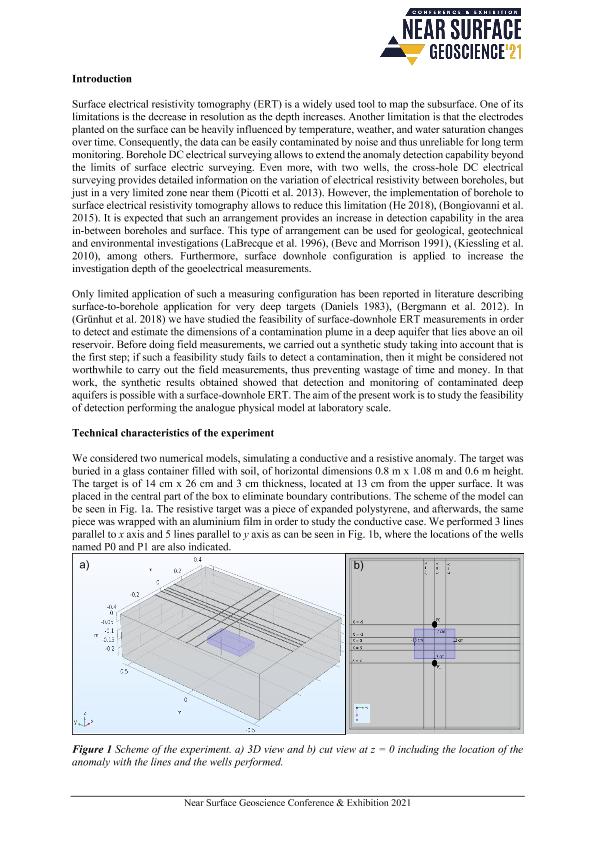Mostrar el registro sencillo del ítem
dc.contributor.author
Bongiovanni, Maria Victoria Flavia

dc.contributor.author
Grünhut Duenyas, Vivian

dc.contributor.author
López, Ernesto
dc.date.available
2022-06-02T03:31:17Z
dc.date.issued
2021
dc.identifier.citation
A physical model to study deep contaminated sites: ERT study with surface-downhole electrode configuration; NSG2021 27th European Meeting of Environmental and Engineering Geophysics; Francia; 2021; 1-5
dc.identifier.issn
1028-3668
dc.identifier.uri
http://hdl.handle.net/11336/158703
dc.description.abstract
Surface electrical resistivity tomography (ERT) is a widely used tool to map the subsurface. One of its limitations is the decrease in resolution as the depth increases. Another limitation is that the electrodes planted on the surface can be heavily influenced by temperature, weather, and water saturation changes over time. Consequently, the data can be easily contaminated by noise and thus unreliable for long term monitoring. Borehole DC electrical surveying allows to extend the anomaly detection capability beyond the limits of surface electric surveying. Even more, with two wells, the cross-hole DC electrical surveying provides detailed information on the variation of electrical resistivity between boreholes, but just in a very limited zone near them (Picotti et al. 2013). However, the implementation of borehole to surface electrical resistivity tomography allows to reduce this limitation (He 2018), (Bongiovanni et al. 2015). It is expected that such an arrangement provides an increase in detection capability in the area in-between boreholes and surface. This type of arrangement can be used for geological, geotechnical and environmental investigations (LaBrecque et al. 1996), (Bevc and Morrison 1991), (Kiessling et al. 2010), among others. Furthermore, surface downhole configuration is applied to increase the investigation depth of the geoelectrical measurements. Only limited application of such a measuring configuration has been reported in literature describing surface-to-borehole application for very deep targets (Daniels 1983), (Bergmann et al. 2012). In (Grünhut et al. 2018) we have studied the feasibility of surface-downhole ERT measurements in order to detect and estimate the dimensions of a contamination plume in a deep aquifer that lies above an oil reservoir. Before doing field measurements, we carried out a synthetic study taking into account that is the first step; if such a feasibility study fails to detect a contamination, then it might be considered not worthwhile to carry out the field measurements, thus preventing wastage of time and money. In that work, the synthetic results obtained showed that detection and monitoring of contaminated deep aquifers is possible with a surface-downhole ERT. The aim of the present work is to study the feasibility of detection performing the analogue physical model at laboratory scale.
dc.format
application/pdf
dc.language.iso
eng
dc.publisher
European Association of Geoscientists & Engineers
dc.rights
info:eu-repo/semantics/openAccess
dc.rights.uri
https://creativecommons.org/licenses/by-nc-sa/2.5/ar/
dc.subject
GEOELÉCTRICA
dc.subject
ERT
dc.subject.classification
Otras Ciencias de la Tierra y relacionadas con el Medio Ambiente

dc.subject.classification
Ciencias de la Tierra y relacionadas con el Medio Ambiente

dc.subject.classification
CIENCIAS NATURALES Y EXACTAS

dc.title
A physical model to study deep contaminated sites: ERT study with surface-downhole electrode configuration
dc.type
info:eu-repo/semantics/publishedVersion
dc.type
info:eu-repo/semantics/conferenceObject
dc.type
info:ar-repo/semantics/documento de conferencia
dc.date.updated
2022-05-12T06:24:02Z
dc.identifier.eissn
1369-4081
dc.journal.volume
2021
dc.journal.pagination
1-5
dc.journal.pais
Francia

dc.journal.ciudad
Bordeaux
dc.description.fil
Fil: Bongiovanni, Maria Victoria Flavia. Universidad Austral. Facultad de Ingeniería. Departamento de Ciencias Básicas; Argentina. Consejo Nacional de Investigaciones Científicas y Técnicas; Argentina
dc.description.fil
Fil: Grünhut Duenyas, Vivian. Universidad Austral. Facultad de Ingeniería. Departamento de Ciencias Básicas; Argentina. Consejo Nacional de Investigaciones Científicas y Técnicas; Argentina
dc.description.fil
Fil: López, Ernesto. Universidad de Buenos Aires. Facultad de Ciencias Exactas y Naturales. Departamento de Física; Argentina. Universidad de Buenos Aires. Ciclo Básico Común; Argentina
dc.relation.alternativeid
info:eu-repo/semantics/altIdentifier/url/https://www.earthdoc.org/content/papers/10.3997/2214-4609.202120177
dc.relation.alternativeid
info:eu-repo/semantics/altIdentifier/url/https://eage.eventsair.com/nsg2021/
dc.conicet.rol
Autor

dc.conicet.rol
Autor

dc.conicet.rol
Autor

dc.coverage
Internacional
dc.type.subtype
Conferencia
dc.description.nombreEvento
NSG2021 27th European Meeting of Environmental and Engineering Geophysics
dc.date.evento
2021-08-29
dc.description.paisEvento
Francia

dc.type.publicacion
Journal
dc.description.institucionOrganizadora
European Association of Geoscientists & Engineers
dc.source.libro
Conference Proceedings, Near Surface Geoscience Conference & Exhibition 27th European Meeting of Environmental and Engineering Geophysics
dc.date.eventoHasta
2021-09-02
dc.type
Conferencia
Archivos asociados
